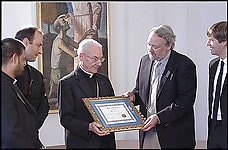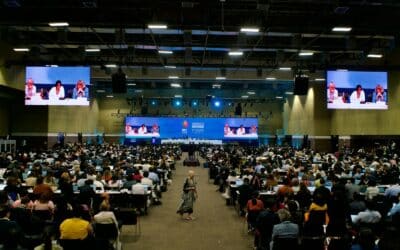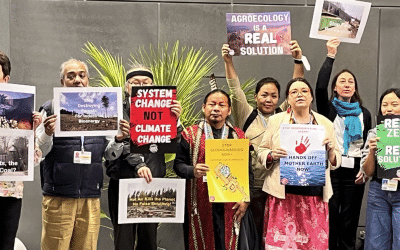Firm’s Emission Plans Have Critics Aplenty
by Steven Mufson (Washington Post)

Cardinal Paul Poupard accepts a carbon-credit donation from Planktos chief executive Russ George, whose firm hopes to make the Vatican the first carbon-neutral sovereign state. (Business Wire)
A small California company is planning to mix up to 80 tons of iron particles into the Pacific Ocean 350 miles west of the Galapagos islands to see whether it can make a splash in the markets where people seek to offset their greenhouse gas emissions.
Planktos — with 24 employees, a Web site and virtually no revenue — has raised money to send a 115-foot boat called the Weatherbird II on a voyage to stimulate the growth of plankton that could boost the ocean’s ability to absorb carbon dioxide from the air. The company plans to estimate the amount of carbon dioxide captured and sell it on the nascent carbon-trading markets.
The boat is still in Florida, but the plan has already stirred the waters in Washington. Environmental groups say the Planktos project could have unforeseen side effects, and the Environmental Protection Agency has warned that the action may be subject to regulation under the Ocean Dumping Act.
Disputes like the one over Planktos may be the wave of the future in the new carbon-conscious era. As countries and companies seek to slow climate change, taking carbon dioxide out of the atmosphere can be financially rewarding.
In a bid for attention for another of its projects, Planktos said earlier this month it would offset the Vatican’s carbon emissions by donating credits from trees being planted in a Hungarian national forest. The company said it would make the Holy See “the world’s first carbon-neutral sovereign state.” It released a video that panned across St. Peter’s Square to music from Johann Sebastian Bach’s “St. Matthew Passion” and then cut to Cardinal Paul Poupard, who thanked Planktos chief executive Russ George.
Other groups have looked on the company with less indulgence. The Surface Ocean Lower Atmosphere Study, an international research group, said last month that “ocean fertilization will be ineffective and potentially deleterious, and should not be used as a strategy for offsetting CO2 emissions.” The International Maritime Organization scientific group, the Friends of the Earth and the World Wildlife Fund have condemned it. And a group called the Sea Shepherd Conservation Society said its own ship would monitor the Planktos vessel and possibly “intercept” it.
On Wednesday, George appeared before the House Select Committee on Energy Independence and Global Warming and lashed back at his critics. The EPA was working with “radical environmental groups,” he said. In written submissions, he said his firm’s work had been “falsely portrayed” to “generate public alarm.”
Planktos’s Web site boasts that it “offers investors the single most powerful, profitable, and planet-friendly tool in the worldwide battle against global warming.” Though its revenue amounts to a few thousand dollars, raised by selling “a few thousand tons” of credits to individuals and small businesses largely through its online “store,” the Foster City, Calif., company has a market value of $91.4 million.
Serious science is involved in the company’s ocean concept. Planktos plans to suck water from the ocean, insert the equivalent of a teaspoon of iron into a volume equal to an Olympic-size pool, and pump the water back into the ocean as the ship makes a grid about 62 miles by 62 miles — “like plowing a field,” one Planktos official said.
Iron is a nutrient for phytoplankton, which absorb carbon dioxide from the air and convert it to carbon and oxygen through photosynthesis. The plankton blooms form within a day or two and last six months. The tropical Pacific Ocean is widely regarded as a good spot to experiment because there is relatively little iron-rich dust carried from land, but there are other nutrients. George said “it’s the clearest ocean on Earth because it’s lifeless, and it’s not supposed to be that way.”
George asserts that the potential is enormous. He said that the annual drop in ocean plant life was like losing all the rain forests every year. “If we succeed, we’ll have created an industry,” he told the House committee. “If we don’t succeed, we’ll have created a lot of great science.”
But leading ocean and climate experts have poured cold water on the Planktos plan by saying that the company can’t accurately measure how much additional carbon would be stored in the ocean or for how long. One reason: Some organisms sink and store carbon deep below the surface. But the overwhelming majority are eaten by fish or other organisms that convert the carbon back into carbon dioxide.
“Actually knowing how much carbon stays down there is a really hard thing,” says Daniel Schrag, director of the Harvard University Center for the Environment.
Schrag said the Planktos project could also generate new algae, which could reduce the amount of oxygen at depths that would endanger other ocean life. “Doing a large-scale ecological experiment before you understand the system is a dangerous thing,” he said.
Others doubt the benefits. “I think iron fertilization in the ocean is not going to make a significant difference to the CO2” problem, said Wally Broecker, a professor of earth and environmental sciences at Columbia University.
There are other issues. The area is in international waters, so some critics ask why Planktos or any company should be able to reap profits there. And if the company started selling large amounts of ocean-based carbon credits, it could flood the market, reducing incentives for more reliable and measurable projects aimed at reducing greenhouse gases in the atmosphere.
In addition, the benefits of reforestation projects are almost as hard to measure as ocean plankton, and people at funds that trade carbon credits are raising questions about Planktos’s Hungarian forest project. Although the project is in Europe, it remains unclear whether any forest projects will meet the strict standards for credits that can be sold in the European Union’s cap-and-trade system, where credits currently sell for $26.85 per ton of carbon dioxide.
So how is Planktos going to offset the Vatican’s emissions? The Vatican doesn’t emit much — about as much as 500 U.S. households, says David Kubiak of Planktos. To offset the Vatican’s current emissions, Planktos is using credits that it expects to receive from its Hungarian tree-planting venture — in the future. Those new seedlings won’t produce carbon benefits for eight years, Kubiak said.
The Vatican isn’t part of the E.U. cap-and-trade system, so Planktos can use the credits even if they do not meet E.U. standards. These are called voluntary credits because the buyers, like those in the United States, are not required to offset emissions. The voluntary credits trade at a fraction of the price that E.U.-certified credits do.
Many companies are calling for Congress to set standards for voluntary credits if it does not establish a U.S. version of Europe’s more rigorous cap-and-trade rules.
“The global market for voluntary carbon offsets is currently unregulated,” said Derik Broekhoff, senior associate at the World Resources Institute, “which has led to growing concerns about whether buyers are really getting what they are paying for.”


